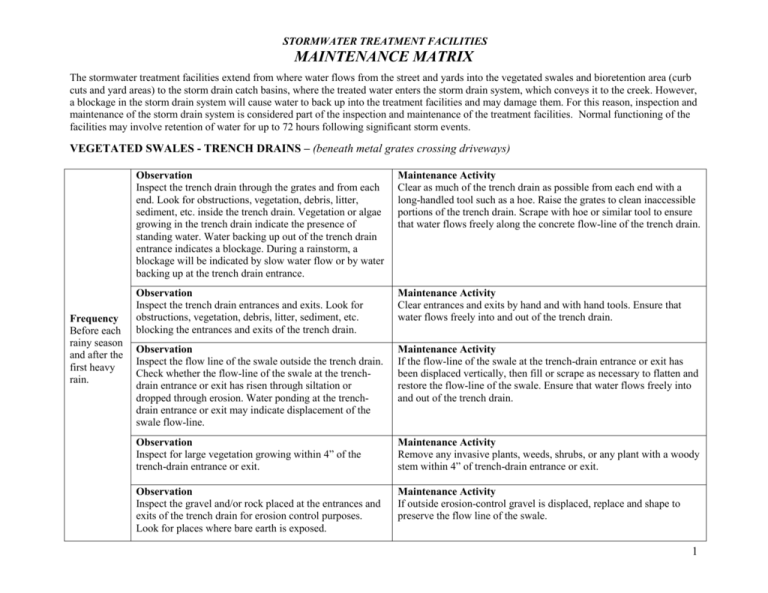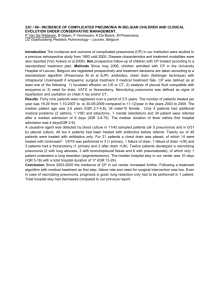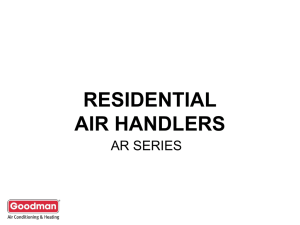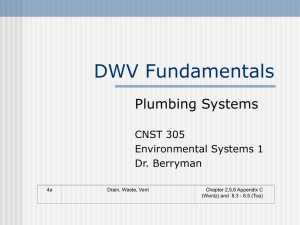STORMWATER TREATMENT FACILITIES MAINTENANCE MATRIX
advertisement

STORMWATER TREATMENT FACILITIES MAINTENANCE MATRIX The stormwater treatment facilities extend from where water flows from the street and yards into the vegetated swales and bioretention area (curb cuts and yard areas) to the storm drain catch basins, where the treated water enters the storm drain system, which conveys it to the creek. However, a blockage in the storm drain system will cause water to back up into the treatment facilities and may damage them. For this reason, inspection and maintenance of the storm drain system is considered part of the inspection and maintenance of the treatment facilities. Normal functioning of the facilities may involve retention of water for up to 72 hours following significant storm events. VEGETATED SWALES - TRENCH DRAINS – (beneath metal grates crossing driveways) Frequency Before each rainy season and after the first heavy rain. Observation Inspect the trench drain through the grates and from each end. Look for obstructions, vegetation, debris, litter, sediment, etc. inside the trench drain. Vegetation or algae growing in the trench drain indicate the presence of standing water. Water backing up out of the trench drain entrance indicates a blockage. During a rainstorm, a blockage will be indicated by slow water flow or by water backing up at the trench drain entrance. Maintenance Activity Clear as much of the trench drain as possible from each end with a long-handled tool such as a hoe. Raise the grates to clean inaccessible portions of the trench drain. Scrape with hoe or similar tool to ensure that water flows freely along the concrete flow-line of the trench drain. Observation Inspect the trench drain entrances and exits. Look for obstructions, vegetation, debris, litter, sediment, etc. blocking the entrances and exits of the trench drain. Maintenance Activity Clear entrances and exits by hand and with hand tools. Ensure that water flows freely into and out of the trench drain. Observation Inspect the flow line of the swale outside the trench drain. Check whether the flow-line of the swale at the trenchdrain entrance or exit has risen through siltation or dropped through erosion. Water ponding at the trenchdrain entrance or exit may indicate displacement of the swale flow-line. Maintenance Activity If the flow-line of the swale at the trench-drain entrance or exit has been displaced vertically, then fill or scrape as necessary to flatten and restore the flow-line of the swale. Ensure that water flows freely into and out of the trench drain. Observation Inspect for large vegetation growing within 4” of the trench-drain entrance or exit. Maintenance Activity Remove any invasive plants, weeds, shrubs, or any plant with a woody stem within 4” of trench-drain entrance or exit. Observation Inspect the gravel and/or rock placed at the entrances and exits of the trench drain for erosion control purposes. Look for places where bare earth is exposed. Maintenance Activity If outside erosion-control gravel is displaced, replace and shape to preserve the flow line of the swale. 1 STORM DRAIN SYSTEM Observation Inspect the storm drain outfall at the creek. Look for obstructions, vegetation, debris, litter, sediment, etc. blocking the outfall. Check for bushes, trees, or other Frequency Before each dense vegetation growing immediately in front of the rainy season. outfall. Frequency Before each rainy season and after the first heavy rain. Maintenance Activity Remove obstructions, etc. Observation Inspect all catch basins. Look for obstructions, vegetation, debris, litter, sediment, etc. blocking the catch basins. Maintenance Activity Remove obstructions, etc. Observation Inspect the entire storm drain system from the upstream end to the outfall, including all catch basins. Observe the flow of water. Any evidence of ponding in the catch basins indicates a blockage. Maintenance Activity Find and remove any obstructions. Flushing may be necessary. 2 VEGETATED SWALES AND BIORETENTION AREA – SUBDRAINS Frequency Before each rainy season Observation Inspect all subdrain cleanouts. Ensure that all cleanout caps are present. Look for obstructions, debris, trash, leaves, vegetation, etc. growing inside the subdrain or covering the cleanout. Maintenance Activity Remove any obstructions by hand (if near the cleanout entrance) or by flushing (with pressurized water) if too far down the pipe. Replace missing caps and secure to prevent unauthorized removal or accidental displacement. Observation Maintenance Activity Inspect each subdrain where it enters the catch basin to see If water does not flow through the subdrain, rod or flush the line to whether the subdrain pipe is dry, or is clogged with ensure flow. vegetation. Ensure that the subdrain is flowing by testing with water from the cleanout end. 3 VEGETATED SWALES AND BIORETENTION AREA - GENERAL Observation Inspect curb cuts (gaps in curb for water to flow down to treatment facility). Look for any obstructions that will prevent water from leaving the street and flowing into the treatment facility. This includes litter, debris and vegetation. There should be at least a 1-inch drop from the curb cut to the erosion control rock. No vegetation should obstruct the flow of water through the curb cut. Frequency Before each rainy season Maintenance Activity Remove obstructions, clean litter and cut vegetation. Observation Inspect bank between curb cuts and treatment facility. Look for gullies, washouts, evidence of uncontrolled surface water flow or any other evidence of distress to the slope. Maintenance Activity Repair bank by excavating gullies and replacing soil in its original configuration, properly compacted. Replace gravel or other erosion control device so that bank does not erode again. Observation Determine whether the bioretention area / swale is draining correctly. Inspect adjacent infrastructure, such as retaining walls, curbs and pavement for signs of failure caused by water intrusion into the surrounding soil. This is a sign of poor drainage from the treatment facility. Maintenance Activity Determine the cause of the poor drainage (i.e. siltation of “sandy loam” soil mix, blocked subdrains, blocked catch basin, blocked storm drain) and repair. Frequency After the first heavy rain. Observation Determine whether the bioretention area / swale is draining correctly. Look for standing water or soggy, saturated soil. Look for holes containing standing water and permitting mosquitoes. This is a sign of poor drainage from the treatment facility. Water should drain from bioretention area / swale within 72 hours. After 72 hours, there should be no patches of standing water – bioretention area / swale should drain evenly. Maintenance Activity Determine the cause of the poor drainage (siltation of “sandy loam” soil mix, blocked subdrains, blocked catch basin, blocked storm drain) and repair. Fill holes containing standing water with “sandy loam” soil mix. Tilling of “sandy loam” soil mix may be required. After several years, the soil medium may become impermeable because of silt deposition, in which case removal and replacement of the “sandy loam” soil mix and gravel will be required Frequency Each month Observation Inspect the bioretention area / swale for litter, debris, leaves, dead vegetation and anything else that might interfere with flow, filtration or growth of grass. Maintenance Activity Remove all such litter, debris, leaves, dead vegetation, etc. by hand or with hand tools. Replace dead vegetation as appropriate. Frequency Each month Observation Inspect for growth of trees or invasive plants in grassy bioretention area / swale areas. Maintenance Activity Remove invasive plants, weeds, shrubs, trees, or anything with a woody stem from grassy bioretention area / swale areas. 4 Observation Inspect condition of grass in bioretention area / swale. Grass must be of sufficient density and health to provide filtration and protect from erosion. Maintenance Activity Mow as necessary, fertilize as necessary, note bare spots and reseed as necessary, remove dead grass and reseed as necessary. Fertilization is to be performed by a licensed professional. Only the minimum effective amount of fertilizer is to be used, to prevent downstream eutrification. Fertilizers used should be the most environmentally benign products available. Frequency Before each dry season and each month throughout the dry season. Observation Test the irrigation system. Observe whether all grassy areas in the bioretention area / swale are receiving the correct amount of water. Observe whether excessive irrigation is creating flow in the subdrains (irrigation should not cause any flow in subdrain). Maintenance Activity Clean out all plugged sprinkler heads and filters. Straighten any displaced sprinkler heads. Replace any damaged sprinkler heads. Adjust for correct direction and throw distance. Set the sprinkler timer to provide enough water depending on the anticipated weather until the next irrigation inspection. Reduce the watering time if excess water flows from the subdrains. Frequency Each month. Observation Inspect for presence of pests which constitute a nuisance and/or threaten the survival of the grass in the bioretention area / swale. Maintenance Activity Apply pesticide to the minimum amount necessary to control pests. All application of pesticide is to be performed by a licensed professional pest control contractor trained in Integrated Pest Management (IPM) techniques. Frequency Ongoing Observation Before making any modification to on-lot swales, downspouts, grading, landscaping or drainage patterns, ascertain what effect such modification will have on the flow of water to the treatment swales and/or bioretention area. Maintenance Activity Refrain from any construction, grading, landscaping, piping or any other construction that will affect the flow of water to the treatment swales and/or bioretention area. Correct any changes that divert stormwater away from treatment facilities or otherwise reduce their effectiveness. Frequency Observation Maintenance Activity When treatment facilities are substantially failing to perform (estimated 15 years from installation) Treatment facilities are failing to drain and/or discharging “dirty water” into creek. Minor maintenance activities have failed to rectify problem. Frequency Each month Thorough inspection of stormwater facility by licensed professional (i.e., landscape contractor, landscape architect, civil engineer, etc.) Replacement of failed components and repair of stormwater facility to design specifications (per the Stormwater Control Plan). 5 6




